Picture from an embodiment workshop I facilitated for a group of Performatory students together with Suzan Lindhout.

In the search for my own practice as transformative social innovator, I started reflecting on what kind of experiences touched and transformed me. I have always been drawn to and fascinated by the performing arts – be it dance, theatre, music, circus or more – and by connecting to them – be it in the role of the viewer, the performer or the producer. Moreover, I find myself to be especially captivated when these disciplines and these roles merge. Such experiences shaped my worldviews, as well as my current TSI practice. They have, furthermore, led me to discover the concept of embodiment, and to explore how emotions and the body are involved in societal transformation.
To elaborate on that, in our study we are learning about designing experiences or facilitating conversations where we try touching upon the unconscious, rather than the solely rational or analytical levels of thinking and being. This is based, on one hand, on a systemic view, which brings the attention to levels beneath the surface – not only events or individual behaviour, but patterns, relationships, structures and mentality. On the other hand, this connects to a phenomenological view of the world which acknowledges the fundamental influence of physicality and emotions on people’s direct lived experience and, thus, on behaviour.
The embodiment thesis, stemming from phenomenology, brings forth the proposition that our experience of the world is determined by the mutual interactions between the physiology of our organism (the body) and our sensorimotor circuit (the mind) with the external environment (our world) (Stanford Encyclopedia of Philosophy, 2021). Therefore, when designing experiences or facilitating conversations we take into account, for instance, the senses, people’s physical abilities or the implicit associations they might have due to their (sub)cultural background. By modelling the environment, which is what we can have most control over, we can touch upon deeper levels, such as identity, social structures, values or world-views. We can consider light, sound, temperature, architecture of the space, tone of voice, touch, social interactions and more as determining factors.
In this way can create metaphysical spaces where people can open up for change. Where they can access deeper levels of consciousness and engage with their own and others’ humanity. Where complex, existential topics can be approached. We can design safe and inspiring spaces where such vulnerability is possible. This is how we transform. We can design experiences which touch upon these deeper levels, making world-views explicit, deconstructing meaning and building it anew. And by creating new meaning, we change the system.
Performing arts are all about creating experiences. Through the conventions of the performance, they transport the audience in a metaphysical space where they are invited and permitted to let go of the constructs of their everyday reality and follow different ‘rules’. Having this permission opens people up to change. In addition to this, more than other art forms, performative practices call for participation and even co-creation. The more the audience is involved and immersed in the experience, the more impactful the experience is on their psyche. This is an opportunity I would like to pursue in my TSI approach. In this quest, observing and learning from other practitioners is valuable. There are several contemporary practices and makers who I find inspiring for developing my own approach. I will elaborate on a few examples.
Inspiring Examples
Connor Schumacher is a choreographer passionate about involving the public in his work, based on the view that “dance is an applied art that gives our bodies the tools to craft our humanity” (Schumacher, 2022). During one of his workshops that I joined, he said something like ‘dance didn’t change my life because I watched it, it changed my life because I did it’. I deeply relate to this, and that is precisely why I am trying to discover my own way of designing transformative experiences through embodiment. In one of his workshops that I attended he explained that he draws inspiration from the queer techno dance scene. Through movement exercises, on techno music from queer artists, he guided the group to explore topics such as consent, personal space or relationships in an embodied way – by moving together and questioning these topics as they are reflected in our bodies rather than discussing them analytically.
You can find his upcoming performances here.
Dansnest is a performance group that takes dance out of the theatre and brings it in people’s environments, in order to tackle social themes. They create a “participatory and binding work process” (Dansnest, 2017), involving participants from diverse layers of society both in the creation and the performance process. For example, they conducted several dance-based interventions in the Dornboos-lijn neighbourhood in Breda, where the residents found it challenging to connect to each other because of their diverse cultural backgrounds. They created embodied experiences to work on this complex topic with the inhabitants. For example, they facilitated an exercise where everyone needed to stand in a line next to each other and move a certain distance without breaking the line. This way they had to work together, and this experience contributed to seeing each other ‘on the same side’ or as collaborators. You can find more pictures of this project here.
The 100 Hands are a dance group who makes interactive physical work. In fact, meeting them – through their performances and the workshops they gave – was a turning point for me in discovering my passion for and delving deeper into dance and embodiment practices. In their performance ‘25feet’, the first one of theirs that I attended, they explore the topic of interpersonal space with the audience, through the body. You can watch a trailer of this performance here.
“In public, people interact with each other from 25 feet (7.6m). (…) By placing the audience together with two performers in a 25ft2 square, everyone – willingly or not – enters each other’s social space. From there, the journey begins and gets closer and closer, into ‘personal’ and ‘intimate’ space: areas where the most violent and intimate physical interactions take place. 25Feet is a sober, effectively designed, interactive dance performance about physical proximity and the dynamics between violence and intimacy.” (Lubberding, 2017)
They introduce some information about interpersonal space, for example about the average distance we tend to take in different interactions, depending on the level of intimacy and familiarity with the other people – how close we stand to strangers, acquaintances or romantic partners. However, they do not just verbally transfer this information, but create an experiential – physical, emotional, sensorial – (nonverbal) conversation on this topic. They do this by involving the audience in physical exercises, such as standing in front of each other at different distances and reflecting on the experience each of those positions creates.
In addition to this, they also perform improvisational partnering pieces which relate to the same topic. For example, they move very close to each other, holding, hugging, kissing and using soft touch or, contrastingly, they jump and run towards each other, pushing and hitting, at first playfully and then gradually more violently. The aim is to create a reaction in the audience, have them feel involved and intervene. In this way, they highlight concrete behaviours and the embodied associations we have with a topic, namely that of interpersonal space. Thus, they create a physical experience through which they move the conversation along the different levels of thinking and being. They showcase behaviour – where do you place yourself in a particular social situation –, beliefs – how do you react to violence –, or identity – who are you in relation to others.
Conclusion
In our study we learn to deal with complex challenges. We learn to work with a systems thinking perspective, according to which we must be able to approach deeper levels of consciousness in individuals in order to create resilient societal change. An embodied perspective helped me understand how systemic change happens on the level of the individual. As our lived experience is fundamental for our mentalities and behaviours, I wondered how I could affect these deeper levels of consciousness so strongly connected to emotions and physicality. I found that performing arts are valuable and inspiring for my own transformative practice. Therefore, I am interested in using performative tools to create spaces where people can connect to their bodies and emotions in order to explore complex challenges on deeper levels.





